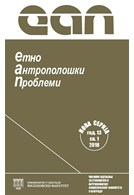Контексти употребе термина Шијак код Јужних Словена у 18. и 19. веку
Contexts in the Use of Terminology Šijak at South Slavs’ in the 18th and 19th Century
Author(s): Uroš ŠešumSubject(s): History, Anthropology
Published by: Филозофски факултет, Универзитет у Београду
Keywords: television; popular culture; aesthetics; TV series Headless rash; Serbia; Yugoslavia
Summary/Abstract: The aim of this paper is to identify the way in which the television TV series Grlom u jagode (Headless Rush) has become cult TV show and piece of popular TV aesthetics. It represents the daily life and social reality, as well as the construction of generational identity in the period of 1960-1969 in Yugoslavia. Headless Rush was produced in 1975 by Srđan Karanovic. It is an original project of a group of young people and a product of the Editorial Staffof the Second Belgrade TV Channel. The paper starts from the assumption that television series as a specific TV discourse participate in the articulation of social practices in a complex political context, thereby significantly affecting the formation, evolution and understanding of the meaning of popular culture. The fact that the discursive field is very broad and very detailed is characteristic for the potential meanings of this series. It represents the attempt to grasp the whole maturation period of a young man in socialist Yugoslavia in the Balkans. This decade has been chosen on purpose because it was important in the growing up of the series’ crew and the other members on the set. Each episode is a comprehensive and complete narrative unit, related to events that took place in only one presented year. Each episode contains the same sentence: „Back in the 196...“ thereby chronologically pointing out to the significant world’s and Yugoslav historical events. Each episode follows the socialization of Bane Bumblebee primarily, and then that of his friends, girlfriends, his sister, as well as his periodical girlfriend Goca. Each episode combines factographies, documentaries, pseudo-factographies, in a narrative and fictional framework. Besides, there is something that might be called pseudo-documentary or out-of-film world in which the characters comment the story line in which they participate. All these elements and patterns create particular aesthetic world.
Journal: Етноантрополошки проблеми
- Issue Year: 13/2018
- Issue No: 1
- Page Range: 83-92
- Page Count: 10
- Language: Serbian

